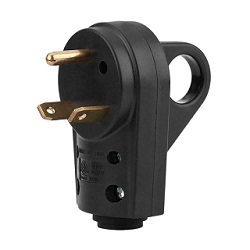![]()
Running RV Air Conditioner on 15 amps & what are “Soft Starters”
DISCLAIMER: AS AN AMAZON ASSOCIATE I EARN FROM QUALIFYING PURCHASES. THIS POST CONTAINS AFFILIATE LINKS THAT WILL REWARD ME MONETARILY OR OTHERWISE WHEN YOU USE THEM TO MAKE QUALIFYING PURCHASES. FOR MORE INFORMATION, PLEASE READ MY EARNINGS DISCLAIMER.
|
Even though an RV air conditioner can probably run on 15 amps of power (depending on the model), usually, it’s a start-up surge that triggers the breakers! But there are some options for “suppressing” your A/C’s initial surge with soft starters, inverter-chargers, and UPS.
Isn’t it “fun” to arrive at your long-awaited destination and only have a 15-amp outlet available to you? You may be able to get away with it if your air conditioner is small enough, but only if you are NOT using anything else at the same time!
If you plug in your 30-amp or 50-amp service RV into a 15-amp outlet and start using your air conditioner, it is highly likely that the circuit will be overloaded and the breaker will trip. In a worst-case scenario, you will have an overheating problem:
Examine carefully the rating of your A/C and how large is the surge rating. If you know the watts, you can easily calculate the amps needed by dividing them by volts (which is 120 in the USA). For example:
3500 surge watts / 120 volts = 29.9 amps
1500 running watts / 120 = 12.5 amps
From the example above we can clearly see that this air conditioner will not “pass” the 15-amp mark due to a high startup surge. Here are more examples:
| RV Roof A/C | Surge Watts | Running Watts |
| 7K BTU | 1,700 (14.2 amps) | 600 (5 amps) |
| 10K BTU | 2,000 (17 amps) | 700 (6 amps) |
| 13K BTU | 2,750 (23 amps) | 1,250 (10.5 amps) |
| 15K BTU | 3,500 (29.2 amps) | 1500 (12.5 amps) |
In reality, the 15-amp outlet can power quite a bit. Just like in a house, it can easily power your furnace (not electric), fridge, lights, and many other things if you use it smartly.
To get away with it, you need to watch your power usage carefully and that means removing some items from the circuit BEFORE using others (especially a microwave). This way using a 15-amp power service may actually work out for you!
Unfortunately, air conditioners demand too much much electricity and cannot be powered from a 15-amp circuit very simply. The problem is NOT with running watts, but the SURGE WATTS!
To avoid this problem, many RVers decide to:
Purchase a generator for the sole purpose of running an air conditioner!
Not to mention it is a great thing to have in your “travel arsenal” since the RV lifestyle is so uncertain, especially in terms of electrical availability. Generator, Inverter, Converter, and deep cycle batteries are basic things that you need to acquire to be comfortable with power usage while traveling in your RV.
The majority of RVs are designed to be connected to the campground’s 50-amp or 30-amp hookups. Now, let’s go over the best ways of connecting both of these RV services to a 15-amp outlet:
Connecting a 30-amp plug into a 15-amp outlet
Of course, you probably realize that in this situation you will NOT be getting 30-amps worth of power! How much will you be getting? 15 amps!
An adapter is required to use the 15-amp service with your RV 30-amp plug:

This Camco adapter for 30-amp service (paid link) is not expensive and Amazon can conveniently ship it to you:
Connecting a 50-amp plug into a 15-amp outlet
The same type of adapter exists for the 50-amp service. On one end it will have an outlet for your 50-amp plug:

On the other end of the adapter, you can plug into the 15-amp outlet of your RV power post. Here is RVer’s favorite adapter or “dog bone” from Camco (five-star rating, paid link):
Once done connecting your RV to the 15-amp service, let’s see if it’s possible to run your air conditioner on it.
Roof RV air conditioner
Roof air conditioners use 12-16 amps on average. When it comes on, it can draw up to 4 times the amount of power it does when it’s just running (in this case 48-64 amps).
As you can see, this rating is even too much for a 50-amp RV service! The most simple solution that I found for running your A/C on a 15-amp circuit is:
To put your A/C on very low setting during the startup
Once again, this could only work if your air conditioner is reasonably small. Not putting any load on your A/C may reduce the chance of overloading the circuit while it’s kicking in.
After that (if everything works fine) adjust the thermostat to a comfortable temperature and operate the air conditioner on the lowest setting you can get away with.
** Important! In the situation that your A/C does start, DO NOT use anything else on this circuit while it is ON!
Soft Starters
A soft starter is any mechanism that decreases the torque given to an electric motor (in our case, a compressor in an air conditioner). By lowering the voltage when the motor is first started, the torque and current can be controlled.
Large inrush currents (or surges), can cause motor damage or do not allow large appliances to run on smaller circuits. A soft starter reduces the initial impact on a motor when it is turned ON and gradually increases the voltage.
This “delayed power” protects motors from long-term damage and allows us to 15 or 20-amp circuits for powering an air conditioner. A soft starter does not modify the motor speed, it uses thyristors to allow the voltage to rise more slowly causing the motor to run at full speed during different intervals.
There is an actual “consumer-grade” product that you can use to soften that startup surge of your air conditioner and give you the ability to run it on 15-amp power service:
If you have the needed skills, this is how you install it:
Below is a very popular advanced soft starter from “Soft Start RV” (paid link) that will let you start your A/C while not tripping a breaker:
There is another device that can be used as a soft starter, but it only works on three-phase motors (our air conditioner does NOT qualify for that). It is called:
VFD (Variable Frequency Drive)
Variable Frequency Drives (or VFDs) are used in motor-driven applications to protect equipment like pumps, fans, and conveyors from wear and tear. It is more common to see this type of device in an industrial setting.
VFDs and Soft starters are very similar devices with different internal workings:
Inverter-Charger
Good quality inverter-charger (with power-assist mode) and batteries could be used to suppress surges since your batteries will be used to supply additional amps when needed. Only make sure it is rated with enough wattage and you have a good battery bank behind it.
This model from Victron (paid link) comes with a power assist feature:
It’s a good-quality product that is very popular among RVers. Here is some explanation of how power-assist works:
UPS (Uninterrupted Power Supply)
Uninterrupted Power Supply (also known as UPS) is basically an inverter with a battery in one unit and it can also be used to fall back on when too much power is being demanded by your air conditioner. It will kick in automatically when a shortage of power is detected.
It works the same way as it would during the brownout, to make sure your appliances will get enough power when needed. UPS can help with handling a certain amount of overload for a short period of time.
However, A/C units are considered to be “dirty load” due to constant current spikes and surges and if you do decide to use it this way, make sure:
- There is NO other load connected to this UPS. Dedicate this UPS to your air conditioner to eliminate the risk of damaging your other appliances due to under-voltage once the compressor starts kicking in.
- Oversize UPS to make sure it can actually handle the load. This will eliminate the risk of appliance damage due to under-voltage.
This UPS unit from Tripp Lite can handle surges up to 2,700 watts:
Portable air conditioner to the rescue!
Using a portable air conditioner is a good idea if there are not too many amps available out of your shore power line. Dividing your sleeping area from your living area is also a good idea because this is how you will be able to cool one room at a time.
These air conditioners come in a variety of sizes and if your camping areas are usually with only 15-20 amps of power available, you definitely need to consider its output. For example, this portable A/C below runs on 11 amps and if you manage somehow to “soften” the startup surge with a “soft start” device, then you can use it with a 15-amp power supply:

Just to summarize, here are the main points on how to use your RV air conditioning with a 15-amp outlet (either roof or portable A/C):
- Start your A/C on a low setting
- Use soft starter
- Use inverter-charger in power assist mode
- Use a dedicated UPS (Uninterrupted Power Supply)
Having said that, you can also use a generator to run your air conditioner and you can keep it running for as long as you have fuel in your tank. Many people like this option for the sake of its simplicity.
Save that power!
Did you know that..?
…Replacing your incandescent light bulb with an LED, will allow you to actually use some light, along with an air conditioner!
Why? Because:
10-watt LED lamp gives the same amount of light as a 60-watts incandescent lamp
Now, let’s do the math. If you have 24 lamps in your RV, you can reduce your “lamp” power consumption from 1,440 watts (60 x 24) to 240 watts (10 x 24), which will give you:
1,200-watts in savings!
With so many challenges in our lives and electrical setups in our RV, sometimes we tend to overlook the simplest solutions ????…

You can also search our database:
Attention! This article is for informational purposes ONLY and is NOT a replacement for professional advice! ALWAYS consult your local specialist for an appropriate solution to your problem. All statements, prices, contact information, recommendations, and reviews contained herein came from sources that we believe to be reliable, but the accuracy or completeness thereof is not guaranteed. Please contact the service provider for complete details and updates.







